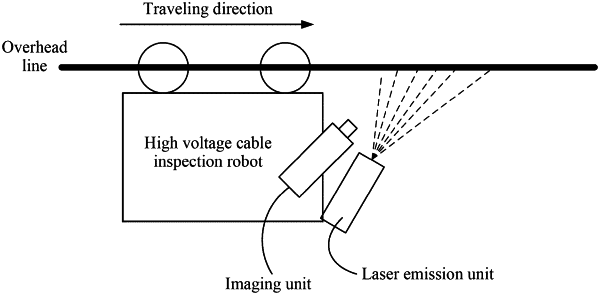| CPC H02G 1/02 (2013.01) [G01N 21/8851 (2013.01)] | 9 Claims |

|
1. An overhead line detection method based on a cable inspection robot, wherein the cable inspection robot is suspended on an overhead line, an imaging unit and a laser emission unit are disposed at a front end of the cable inspection robot, an optical axis of the imaging unit is at a first angle to the overhead line, an optical axis of the laser emission unit is at a second angle to the overhead line, and the overhead line detection method comprises following steps:
controlling the laser emission unit to emit N groups of parallel laser beams to the overhead line to form N parallel laser lines on the overhead line, wherein N is a positive integer;
controlling the imaging unit to shoot the overhead line and the N parallel laser lines to acquire a target detection image;
performing image recognition on the target detection image to acquire N laser line diameters corresponding to the N parallel laser lines on the overhead line, wherein performing image recognition on the target detection image to acquire the N laser line diameters corresponding to the N parallel laser lines on the overhead line specifically comprises:
extracting a light strip with a width of a single pixel from a j-th parallel laser line of the N parallel laser lines by using a thinning algorithm to acquire a j-th light strip centerline, wherein 1≤j≤N, and j is a positive integer;
acquiring a pixel set of the j-th light strip centerline in the target detection image; and
performing least-square circle fitting on the pixel set to acquire a j-th laser line diameter corresponding to the j-th parallel laser line; and
comparing the N laser line diameters with theoretical line diameters at corresponding positions to determine whether the overhead line is abnormal, wherein comparing the N laser line diameters with the theoretical line diameters at corresponding positions to determine whether the overhead line is abnormal specifically comprises:
calculating a distances between all pixels of the j-th light strip centerline and the imaging unit by using a laser triangulation method, and selecting a first distance between a lowest pixel of the j-th light strip centerline and the imaging unit;
acquiring a fitting model, and acquiring a theoretical line diameter corresponding to the j-th laser line diameter according to the first distance by using the fitting model;
comparing the j-th laser line diameter with the theoretical line diameter corresponding to the j-th laser line diameter to determine whether the j-th laser line diameter matches the theoretical line diameter corresponding to the j-th laser line diameter; and
in response to the j-th laser line diameter not matching the theoretical line diameter corresponding to the j-th laser line diameter, determining that the overhead line is abnormal.
|